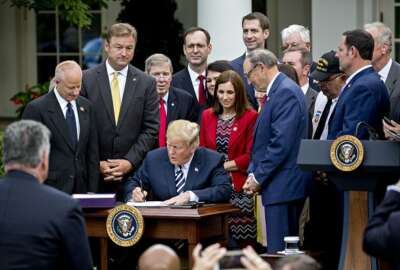

Lawmakers have struck a deal to give the Veterans Affairs Department its biggest budget yet but still lack a long-term plan to fund the agency's new community c...
The Veterans Affairs Department is on track to receive its biggest budget yet, but the agency still doesn’t have a firm, long-term funding path for its new community care program.
A joint congressional conference committee approved $86.5 billion in discretionary funding for VA in 2019, a new high for the department. It’s part of lawmakers’ agreement on a “minibus” of bills, which also include appropriations for energy and water, military construction and the legislative branch.
Congress also agreed to give VA $1.75 billion in discretionary funding to cover community care costs under the VA MISSION Act, which Congress passed earlier this summer. That total is $500 million above what the department originally requested, due to “unanticipated costs in VA’s traditional community care programs,” the conference report on the appropriations bill reads.
Under the Maintaining Internal Systems and Strengthening Integrated Outside Networks (MISSION) Act, VA is supposed to consolidate all previously disparate community care programs into one. The new law builds off a previous one, the Veterans Access, Choice and Accountability (Choice) Act, which Congress passed in 2014.
According to the MISSION Act, VA is expected to begin consolidating and streamlining its original Choice program and other community care programs in May 2019.
Though Congress has designated funding for the MISSION Act in 2019, it still hasn’t struck agreement over how to fund the program in the long term, meaning lawmakers will likely encounter this debate in future years when budget caps are even less certain.
The new law gave VA an additional $5.2 billion to continue Choice through May 2019 while the department implements the new, consolidated community care program. But the MISSION Act doesn’t authorize additional resources to pay for the new program past May 2019 and into 2020.
The new law changed VA’s community care program from mandatory funding to discretionary. Congress did authorize higher spending caps for domestic agencies in 2018 and 2019 with the Bipartisan Budget Act, but it didn’t assume taking on these mandatory costs for VA health care.
The MISSION Act received widespread bipartisan support when Congress passed it into law, but lawmakers have since struggled to agree on how to pay for it.
In announcing their agreement on VA appropriations in 2019, lawmakers offered mixed messages about the agreement they just struck.
“This shift from discretionary, which was not taken into account when the Bipartisan Budget Act caps were established for fiscal year 2019, will likely trigger a need for an additional $1.6 billion in funding, according to the Congressional Budget Office, above what has been provided in this bill,” Senate Appropriations Ranking Member Patrick Leahy (D-Vt.) said in a statement. “That figure could go higher depending on how the VA implements the new program.”
Democrats wanted Congress to adjust the spending caps to keep the VA’s new community care program funded, but Republicans preferred to find a pay-for from other federal programs.
Without a clear long-term funding mechanism, lawmakers will continue this debate in future years.
“The MISSION Act requirements could also require cuts elsewhere in the federal budget of more than $8 billion in fiscal year 2020 and more than $9 billion in fiscal year 2021 unless a solution is found,” Leahy said. “The Trump administration believes that these costs can be accommodated by cutting the National Institutes of Health, eliminating the Low Income Home Energy Assistance Program, and by cutting other veterans programs.”
But Republicans described VA’s minibus agreement as a win.
“VA will receive the funding needed for implementation of the VA MISSION Act while adhering to the existing and necessary caps on federal spending,” Rep. Phil Roe (R-Tenn.), chairman of the House VA Committee, said Tuesday in a statement. “The funds would responsibly allow veterans to have the options for care they deserve while also maintaining our strong investment in VA.”
In the future, conferees are asking VA to provide monthly reports to its appropriations and authorizing committees with more budget details on community care obligations and compare those figures with available appropriations.
“Although the administration indicated a significant portion of the costs were assumed in the
president’s budget request, it has not provided a funding estimate for the consolidated program,” the conference report reads. “Ultimately, the timing of consolidation and any change in cost is dependent on the issuance of regulations that will outline the new program structure.”
VA had consistently struggled to predict how much it would need to pay for the Choice program in the past, often forcing Congress to pass sudden, short-term funding solutions before the funding ran dry.
In addition, VA will receive $1.1 billion toward its electronic health record modernization program in 2019, which the agency started in earnest this year.
Copyright © 2024 Federal News Network. All rights reserved. This website is not intended for users located within the European Economic Area.
Nicole Ogrysko is a reporter for Federal News Network focusing on the federal workforce and federal pay and benefits.
Follow @nogryskoWFED


